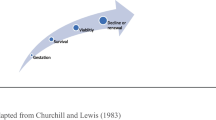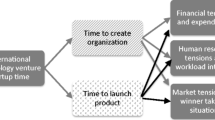Abstract
Technology startups need to launch, simultaneously and quickly, innovative products (or services) and organizations, but some are able to launch more quickly than others. This paper explores how some ventures start up very quickly, and the mechanisms by which accelerator programs assist nascent technology ventures to minimize startup time. Through four in-depth case studies of clean technology ventures that started up quickly, two with and two without the aid of accelerators, the rapid launch of startups is explored and accelerator mechanisms are clarified: survival (starting up quickly is a matter of survival), resource network (starting up quickly requires leveraging pre-existing networks) and catching up (accelerators fill gaps to allow inexperienced entrepreneurs to start up quickly). The three mechanisms speed up the launch process and organize scarcity management to motivate the top management team. The paper proposes to extend the minimum viable product concept to the minimum viable start-up as a consequence of acceleration. These three mechanisms for speeding up innovative venture launch are tied to increasing entrepreneurial orientation in the startup technology firm. The practical perspective assists managers of accelerator programs (university-based, economic development, non-profit or for-profit) to design and implement programs that will more effectively fill gaps to help ventures to start up more quickly.


Similar content being viewed by others
References
Allen, D. N., & McCluskey, R. (1990). Structure, policy, services, and performance in the business incubator industry. Entrepreneurship: Theory & Practice, 15(2), 61–77.
Baum, J. A. C., Calabrese, T., & Silverman, B. S. (2000). Don’t go it alone: Alliance network composition and startups performance in Canadian biotechnology. Strategic Management Journal, 21(3), 267–294. https://doi.org/10.1002/smj.2495.
Bergek, A., & Norrman, C. (2008). Incubator best practice: A framework. Technovation, 28(1–2), 20–28. https://doi.org/10.1016/j.technovation.2007.07.008.
Birley, S. (1985). The role of networks in the entrepreneurial process. Journal of Business Venturing, 1, 107–117.
Blank, S. (2013). Why the lean start-up changes everything. Harvard Business Review, 91(5), 65–72.
Bliemel, M. J., & Flores, R. G. (2015). Defining and differentiating accelerators: Insights from the Australian context. In Academy of management (pp. 1–34). Vancouver, BC. https://doi.org/10.5465/ambpp.2015.14151abstrac.
Bliemel, M. J., Flores, R. G., de Klerk, S., Miles, M. P. P., Costa, B., & Monteiro, P. (2016). The role and performance of accelerators in the Australian startup ecosystem. Department of Industry, Innovation & Science (Made Public 25 May, 2016).
Brush, C. G., Manolova, T. S., & Edelman, L. F. (2008). Properties of emerging organizations: An empirical test. Journal of Business Venturing, 23(5), 547–566. https://doi.org/10.1016/j.jbusvent.2007.09.002.
Burnard, P. (1991). A method of analysing interview transcripts in qualitative research. Nurse Education Today, 11(6), 461–466. https://doi.org/10.1016/0260-6917(91)90009-Y.
Chen, J., Reilly, R. R., & Lynn, G. S. (2005). The impacts of speed-to-market on new product success: The moderating effects of uncertainty. IEEE Transactions on Engineering Management, 52(2), 199–212. https://doi.org/10.1109/TEM.2005.844926.
Clausen, T., & Korneliussen, T. (2012). The relationship between entrepreneurial orientation and speed to the market: The case of incubator firms in Norway. Technovation, 32(9–10), 560–567. https://doi.org/10.1016/j.technovation.2012.05.004.
Cohen, S. (2013). What do accelerators do? Insights from incubators and angels. Innovations: Technology, Governance, Globalization, 8(3/4), 19–25. https://doi.org/10.1162/INOV_a_00184.
Cohen, S., & Hochberg, Y. (2014). Accelerating startups: The seed accelerator phenomenon, Available at SSRN 2418000 1–16. Retrieved from http://papers.ssrn.com/sol3/Papers.cfm?abstract_id=2418000.
De Clercq, D., Fried, V. H., Lehtonen, O., & Sapienza, H. J. (2006). An entrepreneur’s guide to the venture capital galaxy. Academy of Management Perspectives, 20(3), 90–113.
Dempwolf, C., Auer, J., & D’Ippolito, M. (2014). Innovation accelerators: Defining characteristics among startup assistance organizations. Sba.Gov. Retrieved from http://www.sba.gov/sites/default/files/rs425-Innovation-Accelerators-Report-FINAL.pdf.
Eisenhardt, K. M. (1989a). Building theories from case study research. Academy of Management Review, 14(4), 532–550.
Eisenhardt, K. M. (1989b). Making fast strategic decisions in high-velocity environments. The Academy of Management Journal, 32(3), 543–576.
Eisenhardt, K. M., & Graebner, M. E. (2007). Theory building from cases: Opportunities and challenges. Academy of Management Journal, 50(1), 25–32. https://doi.org/10.5465/AMJ.2007.24160888.
Eisenhardt, K. M., & Tabrizi, B. N. (1995). Accelerating adaptive processes: Product innovation in the global computer industry. Administrative Science Quarterly, 40(1), 84–110. https://doi.org/10.2307/2393701.
Graham, P. (2012). How Y combinator started. Retrieved from http://old.ycombinator.com/start.html.
Grandi, A., & Grimaldi, R. (2003). Exploring the networking characteristics of new venture founding teams. Small Business Economics, 21, 329–341.
Greve, A., & Salaff, J. W. (2003). Social networks and entrepreneurship. Entrepreneurship: Theory and Practice, 28(1), 1–22. https://doi.org/10.1111/1540-8520.00029.
Grimaldi, R., & Grandi, A. (2005). Business incubators and new venture creation: An assessment of incubating models. Technovation, 25(2), 111–121.
Hallen, B. L., Bingham, C. B., & Cohen, S. L. (2014). Do accelerators accelerate? A study of venture accelerators as a path to success. In Academy of management proceedings (p. 12955). Academy of Management. http://doi.org/10.5465/AMBPP.2014.185.
Hallen, B. L., Bingham, C., & Cohen, S. (2016). Do accelerators accelerate? The role of indirect learning in new venture development. https://ssrn.com/abstract=2719810.
Harrison, R. T., Mason, C. M., & Girling, P. (2004). Financial bootstrapping and venture development in the software industry. Entrepreneurship & Regional Development, 16(4), 307–333. Retrieved from http://search.ebscohost.com/login.aspx?direct=true&db=bth&AN=14167537.
Hoang, H., & Antoncic, B. (2003). Network-based research in entrepreneurship: A critical review. Journal of Business Venturing, 18(2), 165–187. https://doi.org/10.1016/S0883-9026(02)00081-2.
Hochberg, Y. V. (2016). Accelerating entrepreneurs and ecosystems: The seed accelerator model. Innovation Policy and the Economy, 16(1), 25–51.
Hoffman, D. L., & Radojevich-Kelley, N. (2012). Analysis of accelerator companies: An exploratory case study of their programs, processes, and early results. Small Business Institute Journal, 8(2), 54–70.
Hughes, M., & Morgan, R. E. (2007). Deconstructing the relationship between entrepreneurial orientation and business performance at the embryonic stage of firm growth. Industrial Marketing Management, 36(5), 651–661. https://doi.org/10.1016/j.indmarman.2006.04.003.
Kessler, E. H., & Chakrabarti, A. K. (1996). Innovation speed: A conceptual model of context, antecedents, and outcomes. Academy of Management Review, 21(4), 1143–1191.
Lumpkin, G. T., & Dess, G. G. (1996). Clarifying the entrepreneurial orientation construct and linking it to performance. Academy of Management Review, 21(1), 135–172. https://doi.org/10.2307/258632.
Lumpkin, G. T., & Dess, G. G. (2001). Linking two dimensions of entrepreneurial orientation to firm performance: The moderating role of environment and industry life cycle. Journal of Business Venturing, 16(5), 429–451. https://doi.org/10.1016/S0883-9026(00)00048-3.
Malek, K., Maine, E., & McCarthy, I. P. (2014). A typology of clean technology commercialization accelerators. Journal of Engineering and Technology Management - JET-M, 32, 26–39. https://doi.org/10.1016/j.jengtecman.2013.10.006.
Mechanism. (n.d.). Retrieved November 7, 2016, from https://www.merriam-webster.com/dictionary/mechanism.
Miller, D. (1983). The correlates of entrepreneurship in three types of firms. Management Science, 29(7), 770–791. https://doi.org/10.1287/mnsc.29.7.770.
Page, W., & Garbuio, M. (2016). Corporate accelerators: A new approach to building entrepreneurial communities. In SMS special conference (pp. 1–2).
Patton, D., Warren, L., & Bream, D. (2009). Elements that underpin high-tech business incubation processes. Journal of Technology Transfer, 34(6), 621–636. https://doi.org/10.1007/s10961-009-9105-7.
Pauwels, C., Clarysse, B., Wright, M., & Van Hove, J. (2016). Understanding a new generation incubation model: The accelerator. Technovation, 50–51(October), 13–24. https://doi.org/10.1016/j.technovation.2015.09.003.
Rauch, A., Wiklund, J., Lumpkin, G. T., & Frese, M. (2009). Entrepreneurial orientation and business performance: An assessment of past research and suggestions for the future. Entrepreneurship Theory and Practice, 33(3), 761–787. https://doi.org/10.1111/j.1540-6520.2009.00308.x.
Ries, E. (2011). The lean startup: How today’s entrepreneurs use continuous innovation to create radically successful businesses. New York: Crown Business.
Schein, E. H. (1989). The role of the founder in the creation of organizational culture. Readings in Managerial Psychology. https://doi.org/10.2307/976474.
Scherer, F. M. (2015). First mover advantages and optimal patent protection. Journal of Technology Transfer, 40(4), 559–580. https://doi.org/10.1007/s10961-015-9394-y.
Schoonhoven, C. B., Eisenhardt, K. M., & Lyman, K. (1990). Speeding products to market : Waiting time to first product introduction in new firms. Administrative Science Quarterly, 35(1), 177–207.
Shah, S. K., & Pahnke, E. C. (2014). Parting the ivory curtain: Understanding how universities support a diverse set of startups. Journal of Technology Transfer, 39(5), 780–792. https://doi.org/10.1007/s10961-014-9336-0.
Smith, S. W., & Hannigan, T. J. (2015). Swinging for the Fences: How do top accelerators impact the trajectories of new ventures? In DRUID15. Rome.
Stam, W., & Elfring, T. (2008). Entrepreneurial orientation and new venture performance: The moderating role of intra- and extraindustry social capital. Academy of Management Journal, 51(1), 97–111. https://doi.org/10.5465/AMJ.2008.30744031.
Stayton, J., & Mangematin, V. (2016). Startup time, innovation and organizational emergence: A study of USA-based international technology ventures. Journal of International Entrepreneurship. https://doi.org/10.1007/s10843-016-0183-y.
Teece, D. J. (2010). Business models, business strategy and innovation. Long Range Planning, 43(2–3), 172–194. https://doi.org/10.1016/j.lrp.2009.07.003.
Walter, A., Auer, M., & Ritter, T. (2006). The impact of network capabilities and entrepreneurial orientation on university spin-off performance. Journal of Business Venturing, 21(4), 541–567. https://doi.org/10.1016/j.jbusvent.2005.02.005.
Wong, A., Bhatia, M., & Freeman, Z. (2009). Angel finance: The other venture capital. Strategic Change, 230, 221–230.
Yin, R. K. (2009). Case study research: design and methods (4th ed.). Los Angeles: Sage.
Author information
Authors and Affiliations
Corresponding author
Rights and permissions
About this article
Cite this article
Stayton, J., Mangematin, V. Seed accelerators and the speed of new venture creation. J Technol Transf 44, 1163–1187 (2019). https://doi.org/10.1007/s10961-017-9646-0
Published:
Issue Date:
DOI: https://doi.org/10.1007/s10961-017-9646-0
Keywords
- Accelerators
- Seed accelerators
- Startup accelerators
- Technology commercialization
- Clean technology
- Business incubators
- New venture creation




